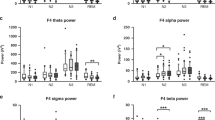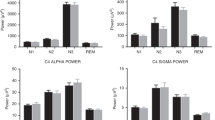Abstract
Purpose
This study aimed to examine slow wave activity (SWA), a marker of homeostatic regulation, as a potential mechanism linking sleep disordered breathing (SDB) with executive dysfunction in children.
Methods
Executive function domains of working memory, spatial planning, information processing, and sustained attention were assessed using the Cambridge Neuropsychological Test Automated Battery (CANTAB) in children (N = 40; 5–12 years) referred for clinical diagnosis of SDB. Polysomnography records of non-snoring, age-matched controls (N = 34) were retrospectively examined for comparison of SWA. Power spectral analysis of the delta wave determined SWA. Group differences in sleep, respiratory, and SWA outcomes were examined. Mean CANTAB scores were compared to standardized norms and correlated against SWA.
Results
Children with SDB showed increased SWA compared to non-snoring controls and scored < 25th percentile for planning accuracy, speed of mental processing, and task efficiency, when compared against population norms. Increasing severity of SDB was associated with an increased difficulty in solving complex tasks and time on task performance. SWA was associated with performance on tasks of early problem solving and efficiency during sustained attention.
Conclusions
SWA, a subtle measure of sleep disruption and sleep regulation, is associated with deficits in problem solving and sustained attention in children with SDB. As current mechanistic theories do not account for deficits observed in children with mild forms of SDB, this study provides a promising alternative.

Similar content being viewed by others
References
Lumeng JC, Chervin RD (2008) Epidemiology of pediatric obstructive sleep apnea. Proc Am Thorac Soc 5:242–252
Marcus CL, Brooks LJ, Draper KA, Gozal D, Halbower AC, Jones J, Schechter MS, Sheldon SH, Spruyt K, Ward SD, Lehmann C, Shiffman RN (2012) Diagnosis and management of childhood obstructive sleep apnea syndrome. Pediatrics 130:576–584
Biggs SN, Nixon GM, Horne RS (2014) The conundrum of primary snoring in children: what are we missing in regards to cognitive and behavioural morbidity? Sleep Med Rev 18:463–475
Anderson P (2002) Assessment and development of executive function (EF) during childhood. Child Neuropsychol 8:71–82
Luciana M, Nelson CA (1998) The functional emergence of prefrontally-guided working memory systems in four- to eight-year-old children. Neuropsychologia 36:273–293
Kohler MJ, Lushington K, Kennedy D (2010) Neurocognitive performance and behavior before and after treatment for sleep-disordered breathing in children. Nat Sci Sleep 2:159–185
Beebe DW, Gozal D (2002) Obstructive sleep apnea and the prefrontal cortex: towards a comprehensive model linking nocturnal upper airway obstruction to daytime cognitive and behavioral deficits. J Sleep Res 11:1–16
Borbely AA, Baumann F, Brandeis D, Strauch I, Lehmann D (1981) Sleep deprivation: effect on sleep stages and EEG power density in man. Electroencephalogr Clin Neurophysiol 51:483–495
Ferrara M, De Gennaro L, Bertini M (1999) The effects of slow-wave sleep (SWS) deprivation and time of night on behavioral performance upon awakening. Physiol Behav 68:55–61
Walsh JK, Hall-Porter JM, Griffin KS, Dodson ER, Forst EH, Curry DT, Eisenstein RD, Schweitzer PK (2010) Enhancing slow wave sleep with sodium oxybate reduces the behavioral and physiological impact of sleep loss. Sleep 33:1217–1225
Biggs SN, Walter LM, Nisbet LC, Jackman AR, Anderson V, Nixon GM, Davey MJ, Trinder J, Hoffmann R, Armitage R, Horne RS (2012) Time course of EEG slow-wave activity in pre-school children with sleep disordered breathing: a possible mechanism for daytime deficits? Sleep Med 13:999–1005
Weichard AJ, Walter LM, Hollis SL, Nixon GM, Davey MJ, Horne RS, Biggs SN (2016) Association between slow-wave activity, cognition and behaviour in children with sleep-disordered breathing. Sleep Med 25:49–55
Ben-Israel N, Zigel Y, Tal A, Segev Y, Tarasiuk A (2011) Adenotonsillectomy improves slow-wave activity in children with obstructive sleep apnoea. Eur Respir J 37:1144–1150
Technical paper: Socio-economic Indexes for Areas (SEIFA). Australian Bureau of Statistics, 2011. (Accessed August, 2014, 2014, at http://www.ausstats.abs.gov.au/ausstats/subscriber.nsf/0/22CEDA8038AF7A0DCA257B3B00116E34/$File/2033.0.55.001 seifa 2011 technical paper.pdf)
Downes J, Evenden J, Morris R, Robbins T, Roberts A, Sahakian B (2006) CANTABeclipse Version 3: Test administration guide. Cambridge Cognition, Cambridge
De Luca CR, Wood SJ, Anderson V, Buchanan JA, Proffitt TM, Mahony K, Pantelis C (2003) Normative data from the CANTAB. I: development of executive function over the lifespan. J Clin Exp Neuropsychol 25:242–254
Luciana M, Nelson CA (2002) Assessment of neuropsychological function through use of the Cambridge neuropsychological testing automated battery: performance in 4- to 12-year-old children. Dev Neuropsychol 22:595–624
Berry RB, Budhiraja R, Gottlieb DJ, Gozal D, Iber C, Kapur VK, Marcus CL, Mehra R, Parthasarathy S, Quan SF, Redline S, Strohl KP, Davidson Ward SL, Tangredi MM (2012) Rules for scoring respiratory events in sleep: update of the 2007 AASM manual for the scoring of sleep and associated events. Deliberations of the Sleep Apnea Definitions Task Force of the American Academy of Sleep Medicine. J Clin Sleep Med 8:597–619
Nixon GM, Hyde M, Biggs SN, Walter LM, Horne RS, Davey MJ (2014) The impact of recent changes to the respiratory scoring rules in pediatrics. J Clin Sleep Med 10:1217–1221
Tabachnick BG, Fidell LS (2001) Using multivariate statistics, 4th edn. Allyn and Bacon, Boston
Czisch M, Wehrle R, Harsay HA, Wetter TC, Holsboer F, Samann PG, Drummond SP (2012) On the need of objective vigilance monitoring: effects of sleep loss on target detection and task-negative activity using combined EEG/fMRI. Front Neurol 3:67
Drummond SP, Bischoff-Grethe A, Dinges DF, Ayalon L, Mednick SC, Meloy MJ (2005) The neural basis of the psychomotor vigilance task. Sleep 28:1059–1068
Raichle ME, MacLeod AM, Snyder AZ, Powers WJ, Gusnard DA, Shulman GL (2001) A default mode of brain function. Proc Natl Acad Sci U S A 98:676–682
Kheirandish-Gozal L, Yoder K, Kulkarni R, Gozal D, Decety J (2014) Preliminary functional MRI neural correlates of executive functioning and empathy in children with obstructive sleep apnea. Sleep 37:587–592
Chan KC, Shi L, So HK, Wang D, Liew AW, Rasalkar DD, Chu CW, Wing YK, Li AM (2014) Neurocognitive dysfunction and grey matter density deficit in children with obstructive sleep apnoea. Sleep Med 15:1055–1061
Beebe DW, Wells CT, Jeffries J, Chini B, Kalra M, Amin R (2004) Neuropsychological effects of pediatric obstructive sleep apnea. J Int Neuropsychol Soc 10:962–975
Bourke R, Anderson V, Yang JS, Jackman AR, Killedar A, Nixon GM, Davey MJ, Walker AM, Trinder J, Horne RS (2011) Cognitive and academic functions are impaired in children with all severities of sleep-disordered breathing. Sleep Med 12:489–496
Betts J, McKay J, Maruff P, Anderson V (2006) The development of sustained attention in children: the effect of age and task load. Child Neuropsychol 12:205–221
Ringli M, Huber R (2011) Developmental aspects of sleep slow waves: linking sleep, brain maturation and behavior. Prog Brain Res 193:63–82
Acknowledgements
The authors wish to thank all the children and their parents who participated in this study and the staff of the Melbourne Children’s Sleep Centre.
Funding
The National Health and Medical Research Council of Australia provided financial support in the form of Project funding (Application 1139620) and the Victorian Government’s Operational Infrastructure Support Program provided financial support to the Hudson Institute of Medical Research. The sponsors had no role in the design or conduct of this research.
Author information
Authors and Affiliations
Corresponding author
Ethics declarations
The Monash University and Monash Health Human Research Ethics Committees granted ethical approval for this project. Written informed consent and verbal assent was obtained. No monetary incentive was provided for participation.
Conflict of interest
All authors certify that they have no affiliations with or involvement in any organization or entity with any financial interest (such as honoraria; educational grants; participation in speakers’ bureaus; membership, employment, consultancies, stock ownership, or other equity interest; and expert testimony or patent-licensing arrangements), or non-financial interest (such as personal or professional relationships, affiliations, knowledge, or beliefs) in the subject matter or materials discussed in this manuscript.
Ethical approval
All procedures performed in studies involving human participants were in accordance with the ethical standards of the institutional and/or national research committee and with the 1964 Helsinki declaration and its later amendments or comparable ethical standards.
Informed consent
Informed consent was obtained from all individual participants included in the study.
Rights and permissions
About this article
Cite this article
Christiansz, J.A., Lappin, C.R., Weichard, A.J. et al. Slow wave activity and executive dysfunction in children with sleep disordered breathing. Sleep Breath 22, 517–525 (2018). https://doi.org/10.1007/s11325-017-1570-x
Received:
Revised:
Accepted:
Published:
Issue Date:
DOI: https://doi.org/10.1007/s11325-017-1570-x




